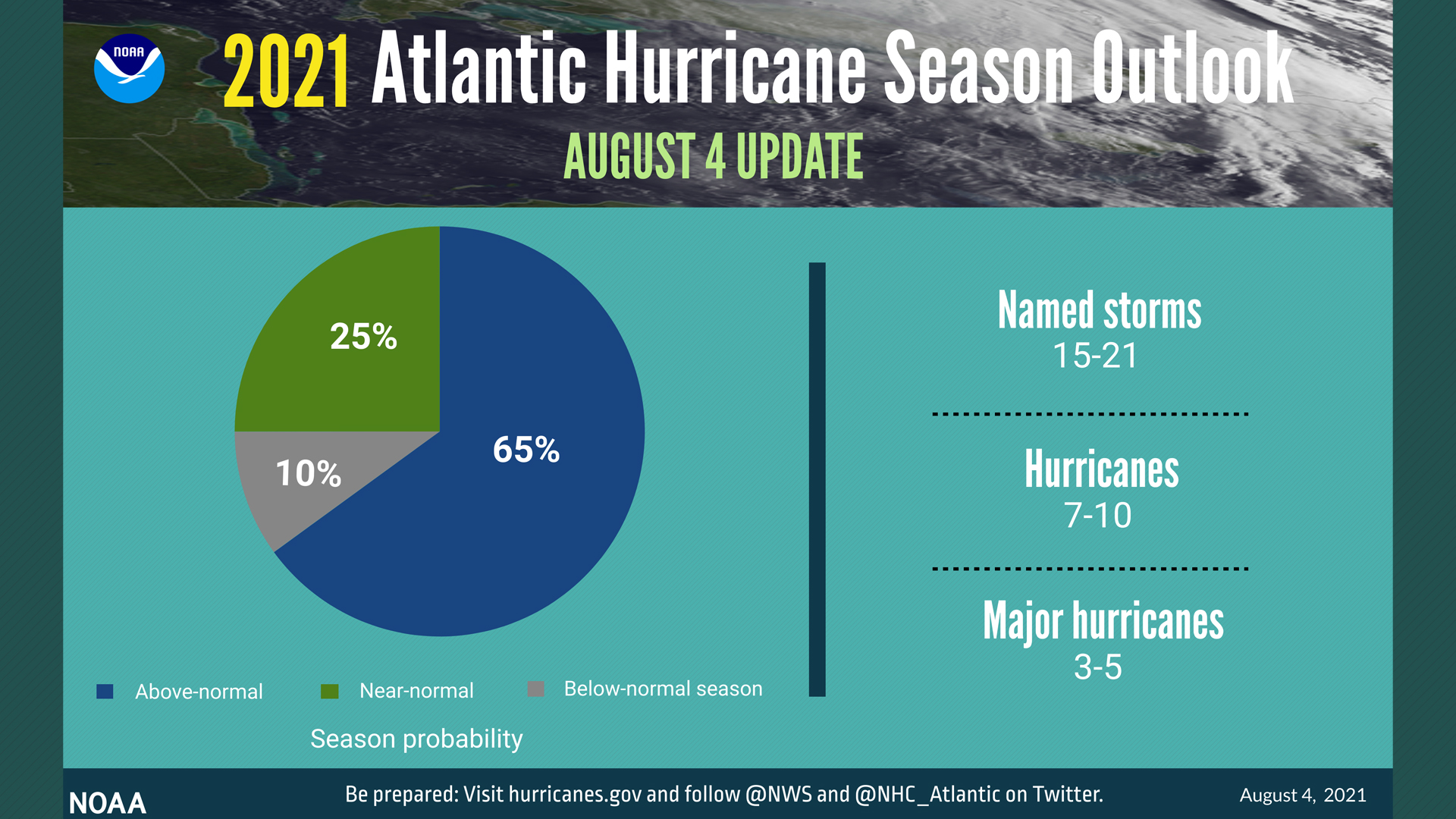This hurricane season will be even more active than previously predicted, NOAA says
An already-active hurricane season shows "no sign of slowing."

It's been just over two months since the 2021 Atlantic hurricane season kicked off on June 1, and we can expect to see even more hurricanes and named storms than experts previously predicted, before the season winds down on Nov. 30.
On Wednesday (Aug. 4), scientists with the National Oceanic and Atmospheric Administration (NOAA) updated their May 20 hurricane season forecast, in an online briefing. They had already warned in May of above-normal hurricane activity, Live Science previously reported, and their update confirmed the presence of atmospheric and ocean conditions that favor higher-than-average storm activity.
One such factor is the growing possibility of an emerging La Niña, a climate pattern that pushes warm waters in the Pacific Ocean toward Asia and carries cooler water to the surface off the western coast of North America, according to NOAA. When La Niña is dominant and waters around the equatorial Pacific are cooler, the Atlantic hurricane season can be more severe, Matthew Rosencrans, lead seasonal hurricane forecaster at NOAA's Climate Prediction Center, said at the briefing.
Related: Hurricane season 2021: How long it lasts and what to expect
In the new outlook, NOAA predicts that the season will see 15 to 21 named storms, compared with the 13 to 20 storms forecast in May. Of those, seven to 10 will likely reach hurricane strength, whereas the May prediction estimated six to 10 hurricanes. There is no change to the number of anticipated major hurricanes — those strengthening to Category 3 or higher, with winds of at least 111 mph (178 km/h) — with three to five such storms expected, Rosencrans said.
"Given the increase in the predicted number of named storms and hurricanes, there is now a 65% chance for an above-normal season and a 25% chance for a near-normal season, with a 10% chance of a below-normal season," he added. However, as sea surface temperatures in the Atlantic are somewhat cooler now than they were at this time last year, it's likely that this hurricane season won't be quite as active as it was in 2020, Rosencrans said.
While the 2021 hurricane season is just getting started, it's already broken a record. Five named storms have formed so far, with number five — Elsa — becoming a hurricane. Elsa, which made landfall in Florida on July 7, was the earliest fifth named storm to form in the Atlantic, Rosencrans said. And the season's activity "does not show any signs of relenting as it enters the peak months ahead," NOAA Administrator Rick Spinrad said in a statement. (Peak hurricane season is mid-August through October.)
Sign up for the Live Science daily newsletter now
Get the world’s most fascinating discoveries delivered straight to your inbox.

How can you prepare for hurricane season, if you live in a high-risk coastal area? Visit the Federal Emergency Management Agency's Ready.gov website for information on how to ready your home before hurricanes strike and how to stay safe during a storm, according to the NOAA statement. You can also visit the National Hurricane Center's Hurricanes.gov website to follow hurricane updates and warnings as storms develop, NOAA says.
"Now is the time to be vigilant about preparedness plans and potential actions," Rosencrans said at the briefing. "Hurricanes are not limited to just damaging winds, but also dangerous storm surge and torrential rain leading to flooding. Regardless of the predicted activity, it does only take one storm to have catastrophic impacts on lives and communities."
Originally published on Live Science.

Mindy Weisberger is an editor at Scholastic and a former Live Science channel editor and senior writer. She has reported on general science, covering climate change, paleontology, biology and space. Mindy studied film at Columbia University; prior to Live Science she produced, wrote and directed media for the American Museum of Natural History in New York City. Her videos about dinosaurs, astrophysics, biodiversity and evolution appear in museums and science centers worldwide, earning awards such as the CINE Golden Eagle and the Communicator Award of Excellence. Her writing has also appeared in Scientific American, The Washington Post and How It Works Magazine. Her book "Rise of the Zombie Bugs: The Surprising Science of Parasitic Mind Control" will be published in spring 2025 by Johns Hopkins University Press.









